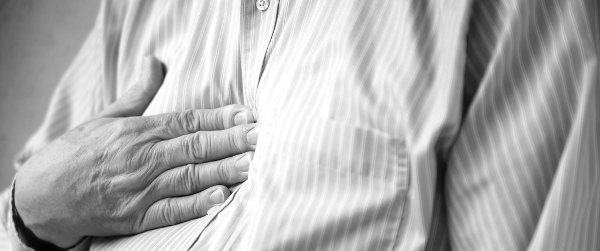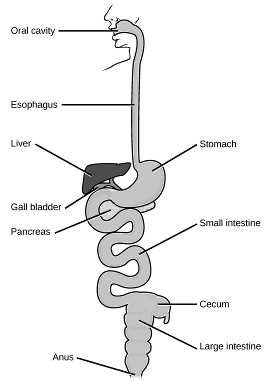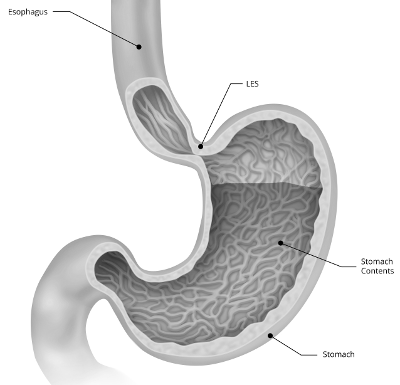Acid-Blockers Overkill

The current treatment protocol for chronic acid-reflux is a crime. To understand why, you will have to first understand how this disease works.
All posts in this series
Introduction Agents of DysbiosisDigestion 101
 The food you swallow travels through a vertical tube called esophagus. Esophagus takes the food into your stomach, where the stomach adds some acid and grinds the food. The acid helps to break down the food and extract nutrients.
The food you swallow travels through a vertical tube called esophagus. Esophagus takes the food into your stomach, where the stomach adds some acid and grinds the food. The acid helps to break down the food and extract nutrients.
After sufficient churning and grinding, the stomach pushes the food into small intestine. As the food travels down the small intestine, more digestion happens. After the food travels some distance in the small intestine, it is mixed with bile which comes from liver (and gall bladder). Bile emulsifies the fat we eat, like soap emulsifies oil, and helps us digest it. Since the bile is alkaline, it neutralizes the acid from the stomach.
In the small intestine, the food is also mixed with various digestive enzymes produced by the pancreas and nutrition extraction happens. After the small intestine is finished digesting the food, the food is moved into our large intestine.
Up until recently, we used to believe that large intestine is largely a waste-bin, holding the digested food till it is excreted. Now we know better. Bacteria living in the large intestine breaks down and eats up our left overs like the fiber that we eat. After the bacteria has done their job, even more energy energy is released (about 30% more) for us to extract from the food.
After the energy extraction, the remaining stuff, with whole lots of stomach bacteria, are stored to be excreted out of the body.
Diaphragm 101
Between our chest and the abdomen, there is a horizontal plane of muscle called the diaphragm. Lungs, heart and esophagus (food pipe) sit above the diaphragm. Stomach, intestines, gall bladder, liver, spleen, pancreas, kidney, urinary tract, etc., sit below the diaphragm.
Diaphragm makes our breathing possible. When we we breath in, the diaphragm moves downward, increasing the volume of our chest cavity. This increases the volume of the lungs, creating a negative pressure inside. Air flows into the lungs to fill it up, creating our in-breathing. When we breath out, the diaphragm moves up, squeezing the lungs and pushing the air out.
Acid Reflux 101
We just saw that the esophagus passes through the diaphragm to reach the stomach. Some of the diaphragm muscle fibers wrap around the esophagus and act like a pinch cock. When you swallow food, the pinch cock opens and allows the food to go down in to the stomach. During other times, it remains closed so that the acidic contents of the stomach don’t escape into the esophagus.
 This pinch cock is called the Lower Esophageal Sphincter valve (or LES valve). When it doesn’t work well, acidic content of the stomach flows back into the esophagus. We call this an acid reflux.
This pinch cock is called the Lower Esophageal Sphincter valve (or LES valve). When it doesn’t work well, acidic content of the stomach flows back into the esophagus. We call this an acid reflux.
Since the esophagus doesn’t have the protective inner lining like stomach, if the acidic stomach contents flow back into the esophagus, the inner surface of the esophagus gets hurt. If the hurt continues for a long time, we are talking years, it might turn into esophageal cancer.
Esophageal cancer is the fastest growing cancer in many parts of the world, including India.
So, there is a sort of compulsion to reduce the damages of long standing acid reflux.
Acid Reflux 201
At times, there is surplus of pressure in/on the stomach which pries open even a normal-strength LES valve and pushes the food back into the esophagus. This is another mechanism through which you might end up getting an acid reflux disease.
Here is the list of all the things that can make the contents of the stomach to flow back into the esophagus:
- Weakness in the diaphragmatic muscle fibers make it difficult to keep the LES valve shut
- There is a hole in the diaphragm (a hiatus hernia), which makes the LES valve weak
- There is too much of food or/and water in the stomach that some of it escapes back into the esophagus
- A faulty digestive system and it produces too much of gas and the pressure from the gas pushes open the LES valve
- Too much of fat in the stomach (called the visceral fat) leaves too little space for the stomach, squeezing its contents out
- Tight clothes like corset put a squeeze on the stomach
- Certain food, like fat and caffeine, dilate the LES valve, making it easy for the acidic contents of the stomach to flow back into the esophagus
Let’s see what we can do fix each possible causes of acid reflux.
- Weak diaphragmatic muscles: You can strengthen them with breathing exercises. Talk to an yoga teacher.
- Hole in the diaphragm (hiatus hernia): Get a surgeon to fix it
- Full stomach: Don’t lie down.
- Gas in digestive system: This may be caused by the drugs you are taking to reduce your acid reflux symptoms. More about it later.
- Too much visceral fat: Lose weight
- Tight clothes: Don’t
- Some foods dilate the LES valve: Avoid them
Other than these, all backward stretching yoga postures stretch the esophagus. It is believed that with the increased length of esophagus, the lateral pressure on the esophagus increases, shutting it more effectively.
Did you notice that none of the above fixes involve reducing the stomach acid?
Stomach Acid 101
Stomach acid is there for two good reasons:
- Stomach acid breaks down the food in the stomach, helping us extract protein and other important nutrients. Without sufficient stomach acid, we tend to become malnutritioned.
- Stomach acid kills most of the pathogens that invade us through the food we eat. Without sufficient stomach acid, we become more susceptible to infections.
Stomach acid is actually a good thing.
SIBO 101
Stomach acid keeps the bacterial content of the stomach acid in check. With weakened stomach acid, there is an over-growth of bacteria in the small intestine. We call this a Small Intestinal Bacterial Overgrowth, or SIBO.
Note: SIBO has many causes. Reduced stomach acid is just one of them.
SIBO has many nasty effects. They include:
- Nausea
- Bloating
- Vomiting
- Diarrhea
- Malnutrition
- Weight loss
- Joint pain
- Fatigue
- Rashes
- Acne
- Eczema
- Asthma
- Depression
SIBO is also very difficult to treat with antibiotics, with very high rate of recurrence. When a recurrence happens, the symptoms are worse.
Let’s look into on only one ill effect of SIBO: Bloating. The bloating occurs because of improper digestion, particularly food fermentation in the small intestine. The gas generated in the process, which causes the bloating, also causes belching.
When the gas from the small intestine travels to the mouth (assuming that the olfactory senses don’t object to it), it opens up a valve positioned between the small intestine and the stomach (called the pyloric valve) and our friend, the LES valve.
Opening the LES valve, we already saw, causes acid reflux. So, when the stomach acid remains sufficiently low for a long time, we are talking months, SIBO to set in. Once SIBO comes to play, it contributes to acid reflux.
If you already have acid reflux, SIBO makes it worse.
Bile Reflux 101
When the contents of the small intestine open up the pyloric valve and travel into the stomach, some times they carries bile from the small intestine into the stomach.
Again, there are other reasons for a bile reflux. SIBO is just one of them.
When the bile, which is alkaline, enters the stomach, it neutralizes some of the stomach acid, making the problem worse.
Acid Reflux Protocol 101
Now that you have your fundamentals, let me take you to the meat of this post: If you have acid reflux and go to a doctor, what do they do? They give you acid-blockers! So that when the stomach contents flow back, your esophagus isn’t burnt the way it used to be. Let me paraphrase that:
Acid-blockers don’t stop the reflux. It simply stops the acid.
Acid blockers, when taken for a long period of time, give you malnutrition, start SIBO and make the acid reflux symptoms worse. Acid blockers turn evil when the treatment runs into months and years.
Pepsin 101
Here is something that no one probably told you about:
If you have acid reflux, the real damage to the esophagus is done by the pepsin that comes from the stomach!
Pepsin is a molecule that is used by the stomach to digest the protein we eat. But pepsin becomes active only in the presence of acid. When you have a reflux, along with the rest of the food contents and acid, even pepsin rises into the esophagus. When the reflux subsides, some of the pepsin hangs around on the walls of the stomach and lies dormant.
Since you now already have pepsin on the esophageal walls, if you happen to eat acidic food or drink acidic drinks, the acid in your food wakes up the pepsin and it starts to digesting your esophagus. Acid reflux is more about pepsin eating into your esophagus and less about the acid burn.
Let me repeat it:
Acid reflux is more about pepsin eating into your esophagus and less about the acid burn.
To reduce the reactivation of pepsin, you have to be careful not to eat or drink acidic foot.
pH 101
When it comes eating less acidic food, how much is too much?
The acidity of substance is measured on a pH scale. pH “0” is very acidic (battery acid). pH 14 is very alkaline (drain cleaner). Lastly, pH is a log scale. “pH 0” is…
- 10 times more acidic than pH 1
- 100 times more acidic than pH 2
- 1,000 times more acidic than pH 3
- 10,000 times more acidic than pH 4
- 100,000 times more acidic than pH 5
- 1,000,000 times more acidic than pH 6
Now that you understand the pH scale, here is something you are never going to forget:
- Water is pH 7.0 (neutral)
- Milk is about pH 6.8 (coconut and soy milk are round about similar value), almost as good as water
- Coffee is about 5.5, a share more acidic than water
- Coke and Pepsi are pH 2.5
- The stomach acid is pH 2
Coke and Pepsi are almost as acidic as the stomach acid. So are many packaged drinks that we use every day.
If you drink acidic drinks or eat acidic food after you have had a reflux, the residual pepsin lingering in your esophagus will get reactivated and start gnawing into the esophageal tissue.
High pH Diet 101
If you are suffering from acid reflux, high the pH of the food you eat lesser you activate the pepsin clinging on to your esophagus.
If you have acid reflux, start eating food that has higher pH value than 5. Do this for two weeks and then stick to pH 4+ food for rest of you life.
With this, about 1/3rd of the people with acid reflux can wean themselves off acid-blocking medication. What more, to keep the pH as high as possible, you will end up eating large quantities of high fiber vegetables, which are excellent for your gut microbiome. So, when you are on high pH diet, you can effectively rule out SIBO.
About 1/3rd of the people with acid reflux can manage with high pH diet and medical intervention. However, the rest 1/3rd typically need surgical correction of their LES valve.
Criminology 101
I started this post with the sensational claim that current standard protocol for “treating” acid reflux disease is a crime. Now that you have the complete picture, are in a better position to understand why:
- About 1/3rd of acid reflux patients can manage their disease with high pH diet. But with the exception of just one organization (Rever’ease) in this country, no one else is even talking about it.
- About 1/3rd of acid reflux patients cannot be cured without a surgery. But most of the chronic acid reflux patients don’t even know that there is permanent fix for their problem in the form of a quick surgery.
- Many patients are not educated about the damage they are doing to themselves by taking acid blocking drugs on the long run.
- Very few acid reflux patients have even heard of SIBO, that it has probably been started by their acid blocking drug, that it is going to be difficult to get rid of it using conventional treatment (i.e. antibiotics) and that it is making their acid reflux worse.
Whoever perpetuates this broken system, in my humble opinion, is committing a crime.
Dysbiosis 101
We already saw that prolonged usage of acid blocking drugs damages the gut bacteria balance, resulting in Small Intestinal Bacterial Overgrowth. Often, these patients are put on antibiotics to get rid of their SIBO. If these things mess up the microbiome so the person starts have symptoms of autoimmune diseases like IBS, allergies, etc., they are also put on steroids to lower the immune response.
This is a deadly cocktail designed for disastrous dysbiosis.
Unless someone wakes up to this and starts to work on re-balancing the gut microbiome, this patient will never become healthy again. Ever.
All posts in this series
Introduction Agents of Dysbiosis